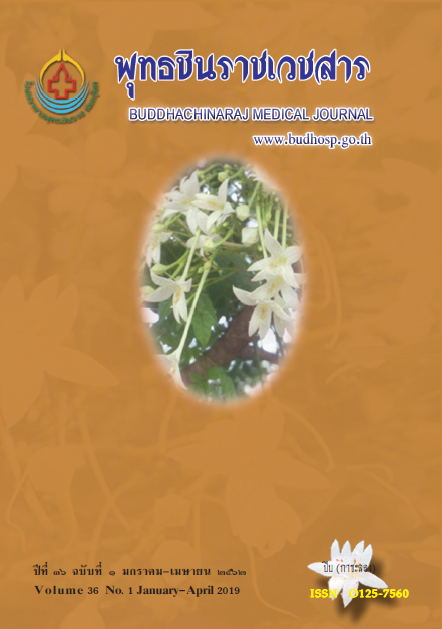แนวปฏิบัติการพยาบาลเพื่อจัดการอาการหายใจหอบเหนื่อย ในผู้ป่วยภาวะหัวใจล้มเหลว:การทบทวนวรรณกรรมแบบบูรณาการ
คำสำคัญ:
แนวปฏิบัติการพยาบาล, การจัดการอาการ, อาการหายใจหอบเหนื่อย, ภาวะหัวใจล้มเหลวบทคัดย่อ
อาการหายใจหอบเหนื่อยพบได้บ่อยในผู้ป่วยที่มีภาวะหัวใจล้มเหลว ทำให้กลับมารักษาซ้ำในโรงพยาบาล บ่อยครั้ง ซึ่งยังไม่มีแนวปฏิบัติที่ชัดเจนในการจัดการอาการดังกล่าว การทบทวนวรรณกรรมแบบบูรณาการครั้งนี้ มีวัตถุประสงค์เพื่อประเมินและสังเคราะห์วรรณกรรมเกี่ยวกับแนวปฏิบัติการพยาบาลเพื่อจัดการอาการหายใจ หอบเหนื่อยในผู้ป่วยภาวะหัวใจล้มเหลว โดยการวิเคราะห์งานวิจัยจากฐานข้อมูล Pubmed, Google Scholar, Ovid, Thailand digital journals, Cochrane, CINIALS, ThaiLISและ Proquest Nursing ปี ค.ศ. 2010-2018 ที่ศึกษา เกี่ยวอาการทางคลินิกและการจัดการอาการหายใจหอบเหนื่อยในผู้ป่วยภาวะหัวใจล้มเหลว จำนวน 21 เรื่อง เป็นงาน วิจัย Level A 11 เรื่อง Level B 2 เรื่อง Level C 4 เรื่อง และ Level D 4 เรื่อง ผลการสังเคราะห์ ดังนี้ 1) การป้องกัน อาการหายใจหอบเหนื่อย ด้วยการให้คำแนะนำในการดูแลตนเอง เรื่องการจำกัดอาหารที่มีโซเดียมสูง จำกัดน้ำดื่ม จัดการการใช้ยาขับปัสสาวะ ฉีดวัคซีนป้องกันไข้หวัดใหญ่และปอดอักเสบ และออกกำลังกาย หลีกเลี่ยงสิ่งที่ทำให้ อาการของโรคเลวลง สอนและฝึกทักษะการประเมินน้ำเข้า-ออก ชั่งน้ำหนัก และเฝ้าระวังอาการตนเอง 2) การประเมิน ปัจจัยที่สัมพันธ์กับการหายใจหอบเหนื่อย และ 3) การจัดการอาการหายใจหอบเหนื่อยทั้งด้วยการไม่ใช้ยาและ การใช้ยา การศึกษาครั้งนี้ เสนอว่าควรพัฒนาแนวปฏิบัติการพยาบาลโดยใช้หลักฐานเชิงประจักษ์อย่างต่อเนื่องและ เหมาะสมกับบริบท รวมทั้งสร้างความตระหนักให้กับพยาบาลในการใช้แนวปฏิบัติและสร้างความมั่นใจได้ในดูแล ที่มีคุณภาพสูงในการจัดการอาการหอบเหนื่อยในผู้ป่วยภาวะหัวใจล้มเหลว โดยพยาบาลต้องมีส่วนร่วมอย่างแข็งขัน ในการพัฒนาแนวปฏิบัติ การนำไปใช้ และการใช้แนวปฏิบัติอย่างต่อเนื่อง
เอกสารอ้างอิง
2. Laothavorn P, Hengrussamee K, Kanjanvanit R, Moleergpoom W, Laorakpongse D, Pachirat O, et al. Thai acute decompensated heart failure registry (Thai ADHERE). CVD Prev Control 2010;5(3):89-95.
3. Roadstean V, Kunsongkeit W, Duangpaeng S. Experiences of dyspnea in patients with heart failure. J Fac Nursing BuraphaUni 2013;21(3):48-59.
4. European Society of Cardiology. 2016 ESC Guidelines for the diagnosis and treatment of acute and chronic heart failure. Eur J Heart Fail 2016;1-85.
5. Kupper N, Bonhof C, Westerhuis B, Widdershoven J. Determinants of dyspnea in chronic heart Failure. J Card Fail 2016;22(3): 201-9.
6. Parshall MB, Schwartzstein RM, Adams L, Banzett RB, Manning HL, Bourbeau J, et al. An official American Thoracic Society statement: update on the mechanisms, assessment, and management of dyspnea. Am J RespirCrit Care Med 2012;185(4):435-52.
7. Zagaria MA. Recognizing causes of dyspnea to prevent hospital admissions. US Pharm 2014;39(7):16-18.
8. Cooper, H. Synthesizing Research A Guide for Literature Reviews. 3rd th. London: SAGE Publications, 1998.
9. The Royal College of Physicians of Thailand. Recommendation Development Clinical Practice guideline. Royal Coll Physic Thai J 2001;18(6):36-46.
10. Rosswurm MA, Larrabee JH. A model for change to evidence-based practice. Image J NursSch 1999;31(4):317-22.
11. Chouihed T, Manzo-Silberman S, Peschanski N, Charpentier S, Elbaz M, Savary D, et al. Management of suspected acute heart failure dyspnea in the emergency department: results from the French prospective multicenter DeFSSICA survey. Scand J Trauma ResuscEmerg Med 2016;24(1):112.
12. Pastorelli M, Capecchi M, Gialli V, Guazzi G, Giordano N,Borselli M, et al. Bedside evaluation of critical dyspnea, Proposal of diagnostic score for acute heart failure in emergency setting. J IntensCrit care 2017;3(2:19):1-7.
13. Delgado ML, Luisa RC, Goyes AB, Cubilos AH, Arsanios DM, Ortiz JM, et al. Opioids for the management of dyspnea in patients with heart failure: a systematic review of the literature. Colombian J anesthesiol 2019;47(1):49-56.
14. Ezekowitz JA, Hernandez AF, O'Conner CM, Starling RC,Proulx G, Weiss MH, et al. Assessment of dyspnes in acute decompensate heart failure. J Am Coll Cardiol 2012:59(16): 1441-8.
15. Mahler DA, Selecky PA, Harrod CG. Management of dyspnea in patients with advanced lung or heart disease: practical guidance from the American college of chest physicians consensus statement. Pol Arch Med Wewn 2010;120(5):160-6.
16. The Heart Association of Thailand under the Royal Patronage of H.M. the King, Heart Failure Society of Thailand. Guidelines for Diagnosis and Treatment of Heart Failure 2014. Bangkok:A-Plus Printing;2014.
17. Kanjanavanit R, Phrommintikul A. Comprehensive heart failure management program. Bangkok:Concept medical;2014.
18. Albert NM. Fluid management strategies in heart failure. Crit Care Nurse 2012;32(2):20-32.
19. Nishino T. Dyspnoea: underlying mechanisms and treatment. Br J Anaesth 2011;106(4): 463-74.
20. Boonprasop S. Dyspnea: The role of a nurse. J HealthSciRes 2012; (6)2:1-11.
21. Coccia CB, Palkowski GH, Schweitzer B, Motsohi T, Ntusi NA. Dyspnoea: Pathophysiology and a clinical approach. S Afr Med J 2016;106(1):32-6.
22. BoonsawatW. Trends in new guideline for COPD In:Chaikuna S. Editor. Current Chest 2012 Contemporary Unguard 2013. Bongkok:Pappim;2013.
23. Johnson MJ, Oxberry SG, Cleland JG, Clark AL. Measurement of breathlessness in clinical trials in patients with chronic heart failure: the need for a standardized approach:
a systematic review. Eur J Heart Fail 2010;12(2):137-47.
24. Ritklar L, Wattana C, Kitipawong P. Effects of a Self-management Program on Selfmanagement Behaviors, Dyspnea, Activities of Daily Living, and Quality of Life among Patients with Congestive Heart Failure.Nurs J 2012;30(1):64-75.
25. Kaewyok T, Wongpiriyayotha A, Nantsupawat W. Effects of self-management program on symptom of dyspnea and functional capacity of persons with congestive heart failure. J Nurs Health Care 2011;29(2):35-40.
26. Kato N, Kinugawa K, Sano M, Seki S, Kogure A, Kobukata K, et al. Developmentof self-care educational material for patients with heart failure in Japan: a pilot study. Nurs Health Sci2012 ;14(2):156-64.
27. Lainscak M, Blue L, Clark AL, Dahlström U, Dickstein K, Ekman I, et al. Self-care management of heart failure: practical recommendations from the Patient Care Committee of the Heart Failure Association of the European Society of Cardiology. Eur J Heart Fail 2011;13(2):115-26.
28. Channakorn N, Daekhunthod T. The development of a clinical nursing practice guideline for the patients with acute heart failure. JSakonNakhonHosp2013;16(3):1-19.
29. Johnson MJ, Oxberry SG. The management of dyspnoea in chronic heart failure. Curr Opin Support Palliat Care 2010;4(2):63-8.
30. McMurray JJ, Adamopoulos S, Anker SD, Auricchio A, B?hm M, Dickstein K, et al. ESC Committee for Practice Guidelines. ESC Guidelines for the diagnosis and treatment of acute and chronic heart failure2012: The Task Force for the Diagnosis and Treatment of Acute and Chronic Heart Failure 2012 of the European Society of Cardiology. Developed in collaboration with the Heart Failure Association (HFA) of the ESC. Eur Heart J 2012;33(14):1787-847.
31.West Yorkshire Cardiac Network. Symptom Management Guidelines for patients in the later stages of heart failure and criteria for referral to specialist palliative care Version 3 2010, [cited 2017 July 1] Availble from:http://www.palliativecare.bradford.nhs.uk/Documents/Symptom% 20Management% 20Guidelines% 20for%20later%20stages%20of%20heart%20failure%20+%20criteria%20for%20ref%20to% 20spec%20pall%20care%200710%20v3.pdf






